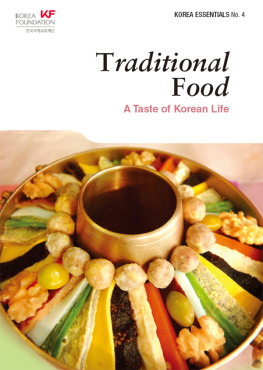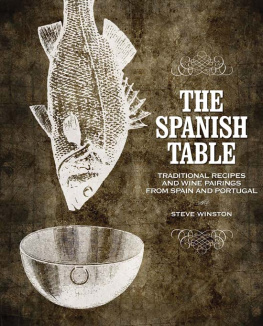

FOR MY PARENTS, BILL AND JOANNE
Text copyright 2013 by Jeff Koehler.
Location photographs and photographs on copyright 2013 by Jeff Koehler.
Plated food photographs copyright 2013 by Kevin Miyazaki.
All rights reserved. No part of this book may be reproduced in any form without written permission from the publisher.
ISBN 978-1-4521-2954-9
Library of Congress Cataloging-in-Publication Data available under:
ISBN 978-0-8118-7501-1
Designed by Alice Chau
Typesetting by Helen Lee
This book is typeset in Peridico, Block Berthold Condensed, Knockout, Duke, DuBois Block, and Rough Riders.
Chronicle Books LLC
680 Second Street
San Francisco, California 94107
www.chroniclebooks.com
ACKNOWLEDGMENTS
The list of those who helped this book in one way or another is longespecially as I began working on it officially four years ago, though in reality more than a decade before that, when I arrived in Spain and initiated my apprenticeship in its kitchen. To the vast number of butchers and bakers, farmers and fishermen, home cooks and chefs who have each offered a piece to this great culinary and cultural puzzle, I offer deep and sincere thanks.
There are a number of people in Spain for whose help I am particularly grateful: Toms Borrs and Rosa Ramrez; Carmina Borrs and Robert Cosials; Rosa Mara Borrs and Ramn Rovira; Marien Borrs and Xicu Garca; Ta Encarnita, Ta Angelita, Ta Fermi, Ta Rosa, and Ta Tere; Nicolas Morales and Pepe Garca; Albert and Jordi Asn; Antoni Cot; Natalia Reixach, Jaime Pascual, and via Lola; Elisabet Ars; Mari-Luz Valero, Jess Mansilla, Juana Ortega, Jess Mansilla (padre), and Juan Aspas; Francisco Nuez de Prado; Eduard Pons; Gerard Ve; David Montegut; Jos Manuel Arias; Jos Melero; Josep Ravell and Jess Benevente; Manuel Prez Pascuas and Juana Gonzlez; Virginia Irurita and her staff at Made for Spain; Jorge Gonzlez, Rben Arnanz, and Inmaculada Casado; Apelio Garca Snchez; Gregoria Carrasco Snchez and family; Pedro Quijorna; Maria Pons and Pere Pons; Sandra Martnez; Eugenia Sarasqueta; Cesc Segura and Eli Jaso; Mark Gregory Peters and Olga Greo; Pilar Rodrguez, Cristina Chiva, and Dani Crdenas; and Caspar.
Outside of Spain, to those in the food and publishing world who were particulary supportive, thank you: Naomi Duguid; Jodi Deleon; Leslie Jonath; Rebecca Staffel; Mary Risley; Sylvia Whitman and Heather Hartley; Mercedes Lamamie and Paz Tintor; James Oseland and Dana Bowen; Justin Paul, Marika Cain, and Melanie Fowler; Jocelyn Zuckerman; Tina Ujlaki and Kate Heddings; Derk Richardson, April Kilcrease, and Tara Guerting; Dick Doughty and Sarah Miller; Jeanne McManus; Michelle Wildgen; Katie Workman and Mary Goodbody; and Sandy Gluck and Lisa Mantineo.
My agent, Doe Coover, and those in her office, including Francis Kennedy, deserve great thanks for their work on this from the very beginning.
And at Chronicle Books, a huge thanks for everything on this book, our fourth together. Warm appreciation to Bill LeBlond, Amy Treadwell, Sarah Billingsley, Vanessa Dina, Steve Kim, Ann Spradlin, Doug Ogan, Claire Fletcher, and Lorena Jones. Thanks to Peter Perez, David Hawk, and Alyson Pullman on the publicity side. And Ann Rolke for her copyediting. Thanks to Alice Chau for her design.
I would like to thank Kevin J. Miyazaki for his fantastic photographic work on the plated dishes. Appreciation also to Ana Torrontegui for her help in Barcelona and Dani Crdenas in finding so much great tableware. And Rosa Mara Borrs and Ramn Rovira for use of their wonderful country place, which has always epitomized the best of the rural kitchen for me.
A huge thanks to my familyespecially my parents, Bill and Joanne, and brother, Billfor their support during the book.
My biggest thanks goes to my two girlsAlba and Maiawho have eaten everything in the book on numerous occasions (or as close to that as any father could ever wish). And to Eva, the reason I came to Spain all those years agoand stayed.
CONTENTS
CHAPTER 1
SOUPS, BROTHS, STEWS, CREAMS, AND PULSES
CHAPTER 2
SALADS, COLD SOUPS, AND GAZPACHOS
CHAPTER 3
TAPAS AND APPETIZERS
CHAPTER 4
VEGETABLES
CHAPTER 5
EGGS
CHAPTER 6
RICE, PASTA, AND MIGAS
CHAPTER 7
FISH
CHAPTER 8
SHELLFISH
CHAPTER 9
POULTRY AND RABBIT
CHAPTER 10
GAME AND SNAILS
CHAPTER 11
MEATS
CHAPTER 12
INNARDS AND EXTREMITIES
CHAPTER 13
DESSERTS, SWEETS, AND FRUITS
CHAPTER 14
DRINKS
CHAPTER 15
SWEET AND SAVORY HOMEMADE CONSERVES
INTRODUCTION
Spanish cooking has never been more in fashion, nor has it ever elicited such interest as it does now. Magazines, newspapers, and TV programs have all tapped in to this cuisine that, apart from a handful of well-known dishes, remains relatively unknown to the average cook. And even tapas and paella, surely the two things that most people associate with the Spanish kitchen (along with molecular gastronomy foams), are largely misunderstood. Master chefs such as Ferran Adri, Joan Roca, and Juan Mari Arzak have been instrumental in drawing attention to Spain and its gastronomy. At times, these culinary alchemists practice something more akin to chemistry in the kitchen, yet in many instances they are deconstructing or riffing on the most rustic of Spanish dishes, striving to elicit emotions frequently rooted in childhood.
I remember some years ago taking a visiting English friend to eat in one of Barcelonas temples of Catalan avant-garde cuisine headed by a prodigy of Adri. The dazzling two-hour tasting menu ended with a finale of toasted bread topped with fruity, aromatic olive oil, swirled mounds of soft chocolate, and some flat flakes of sea salt. My friend was exuberant at such an original combination. I laughed. It was a barely disguised spin on the Friday afternoon snack that my youngest daughter was getting in daycare, the one my wifes school served when she was a girl (this or with quince pasteguess which disappeared first), the one her father ate in the countryside of Lleida as a boy.
Now, I am not suggesting that molecular gastronomy is a modern take on grandmas cooking, but rather that even at this level, with some of worlds most celebrated chefs, many of the dishes, drawn on the flavors of memory, have their roots in the traditional Spanish kitchen. And the traditional kitchen in Spain is the country kitchen.

I moved to Spain over fifteen years ago and not long afterwards married the local girl I had followed here. (We met in London, in a residence hall for foreign graduate students, where we had, somewhat fittingly, shared a kitchen.) One of the things that I have learned during my time eating and cooking here, and traveling to all but one or two of Spains fifty provinces, is that the country kitchen begins firmly with las materias primas, the fresh, high-quality ingredients cooks call the raw materials. These are often simply prepared and presented, with usually just a few other components to draw out flavor. Its a largely straightforward cuisine, rarely overly laborious or complex (which isnt to say unsophisticated or lacking imagination), and more about ingredients than techniques or sauces. Meat, seafood, and poultry are not just vehicles for other, stronger flavors, nor simply bits of texture drowned in an overpowering sauce, but rather cooked for their own flavor. Sometimes that means quickly grilling, other times slowly cooking down to concentrate flavors. Whats the point of buying a good sea bream if you arent going to taste it?
Next page

















